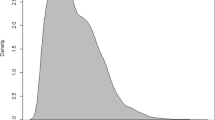Abstract
In the first part of the paper, I analyze a data set on teenage behavior. The data is a sample of high school students in The Netherlands and contains information on teenage time use, income, expenditures, and subjective measures of well-being and self-esteem. As all students in a sampled class are interviewed in principle, the data set has rich information on the behavior of potentially important peers of each respondent. I estimate models to assess (bounds on) the magnitude of endogenous social interactions. For some types of behavior (e.g., truancy, smoking, pocket money, and alcohol expenditures), endogenous social interactions within school classes are strong; for other behaviors, they are moderate or unimportant. Within-gender interactions are generally stronger than interactions between boys and girls, with some intriguing exceptions. In the second part of the paper, I discuss a number of theories that might help to understand the empirical patterns. Key concepts in the discussion are interdependent preferences, endogenous social norms, identity, and intergenerational interactions.
Similar content being viewed by others
References
Akerlof GA, Kranton RE (2002) Identity and schooling: some lessons for the economics of education. J Econ Lit 40:1167–1201
Anderson PM, Butcher KF, Levine PB (2003) Maternal employment and overweight children. J Health Econ 22:477–504
Arcidiacono P, Nicholson S (2005) Peer effects in medical school. J Public Econ 89:327–350
Aronsson T, Blomquist S, Sacklen H (1999) Identifying interdependent behavior in an empirical model of labor supply. J Appl Econ 14:607–626
Burgess S, Propper C, Gardiner K (2002) The economic determinants of truancy. CASE Discussion Paper #61, London School of Economics
Castronova E (2004) Social norms and sexual activity in U.S. high schools. J Hum Resour 39:912–937
Dee TS, Evans WN (2003) Teen drinking and educational attainment: evidence from two-sample instrumental variables estimates. J Labor Econ 21:178–209
Duflo E, Saez E (2002) Participation and investment decisions in a retirement plan: the influence of colleagues’ choices. J Public Econ 85:121–148
Duflo E, Saez E (2003) The role of information and social interactions in retirement plan decisions: evidence from a randomized experiment. Q J Econ 118:815–842
Durlauf SN, Moffitt RA (2003) Introduction to the special issue: empirical analysis of social interactions. J Appl Econ 18:499
Figlio D, Ludwig J (2000) Sex, drugs, and catholic schools: private schooling and non-market adolescent behaviors. NBER working paper #7990
Gaviria A, Raphael S (2001) School-based peer effects and juvenile behavior. Rev Econ Stat 83:257–268
Gruber J (2001) Youth smoking in the 1990’s: why did it rise and what are the long-run implications. Am Econ Rev 91:85–90
Gruber J, Zinman J (2001) Youth smoking in the US: evidence and implications. In: Gruber J (ed) Risky behavior among youth: an economic analysis. University of Chicago Press, Chicago, IL, pp 69–120
Haisken-DeNew JP, Bantle C (2002) Smoke signals: the intergenerational transmission of smoking behavior. Paper presented at the ESPE 2002 conference
Heckman JJ (2003) The supply side of the race between demand and supply: policies to foster skill in the modern economy. De Economist 151:1–34
Heckman JJ, Neal D (1996) Coleman’s contributions to education: theory, research styles and empirical research. In: Clark J (ed) James S. Coleman. Falmer Press, London
Hill MS, Yeung WJJ, Duncan GJ (2001) Childhood family structure and young adult behaviors. J Popul Econ 14:271–299
Kandel E, Lazear EP (1992) Peer pressure and partnerships. J Polit Econ 100:801–817
Kapteyn A, Van de Geer S, Van de Stadt H, Wansbeek T (1997) Interdependent preferences: an econometric analysis. J Appl Econ 12:665–686
Kawaguchi D (2004) Peer effects on substance use among American teenagers. J Popul Econ 17:351–367
Kooreman P (2000) The labeling effect of a child benefit system. Am Econ Rev 90(3):571–583
Kooreman P, Schoonbeek L (2004) Characterizing pareto improvements in an interdependent demand system. J Public Econ Theory 6:427–443
Kuhn P, Weinberger C (2003) Leadership skills and wages. Working paper, University of California, Santa Barbara
Liu H, Mroz T, Van der Klaauw W (2002) Maternal employment, migration, and child development. Working paper, University of North Carolina at Chapel Hill
Manski CF (1993) Identification of endogeneous social effects: the reflection problem. Rev Econ Stud 60:531–542
Manski CF (2000) Economic analysis of social interactions. J Econ Perspect 14:115–136
Pollak RA (1976) Interdependent preferences. Am Econ Rev 66:309–321
Sacerdote B (2001) Peer effects with random assignment: result for Dartmouth roommates. Q J Econ 116:681–703
Soetevent AR, Kooreman P (2004) A discrete choice model with social interactions; with an application to high school teen behavior. J Appl Econ, forthcoming
Thomas D (1990) Intra-household resource allocation; an inferential approach. J Hum Resour 24:635–664
Van Praag BMS (1970) Kindercrêches: wie moet dat betalen? (Who should pay for child care facilities?). Econ-Stat Ber 55:516–517
Van Praag BMS, Cardoso P (2003) How sustainable are old-age pensions in a shrinking population with endogenous labour supply? CES Working Paper #861
Warnaar M, Van Praag BMS (1997) How Dutch teenagers spend their money. De Economist 145:367–397
Woittiez I, Kapteyn A (1998) Social interactions and habit formation in a model of female labour supply. J Public Econ 70:185–205
Author information
Authors and Affiliations
Corresponding author
Additional information
Responsible editor: Christian Dustmann
Revised version of the Presidential Address to the Seventeenth Annual Conference of the European Society for Population Economics (ESPE), New York City, June 15, 2003.
Rights and permissions
About this article
Cite this article
Kooreman, P. Time, money, peers, and parents; some data and theories on teenage behavior. J Popul Econ 20, 9–33 (2007). https://doi.org/10.1007/s00148-006-0121-8
Received:
Accepted:
Published:
Issue Date:
DOI: https://doi.org/10.1007/s00148-006-0121-8




